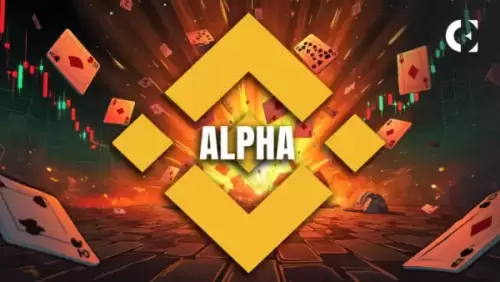 |
|
 |
|
 |
|
 |
|
 |
|
 |
|
 |
|
 |
|
 |
|
 |
|
 |
|
 |
|
 |
|
 |
|
 |
|
Cryptocurrency News Articles
Bitcoin Solaris Enters Its Third Presale Phase at 3 USDT per BTC-S
May 17, 2025 at 04:00 am
In 2013, Litecoin traded for under $3, giving early buyers exposure to exponential gains as adoption expanded. That opportunity is rarely repeated — but today
In 2013, Litecoin traded for less than $3, presenting an opportunity for early buyers to gain massive returns as adoption increased. However, such opportunities rarely repeat. Today, Bitcoin Solaris enters its third presale phase at 3 USDT per BTC-S, backed by a fully audited infrastructure, mobile mining capabilities, and capped supply.
For investors looking for a once-in-a-decade entry point, the similarities are striking, but the architecture and participation model are entirely next-generation. Unlike Litecoin, which required hardware mining and early technical knowledge, Bitcoin Solaris is designed for mass accessibility. Through the Nova App, users can mine BTC-S from their smartphones without specialized equipment or complex setup, allowing new users to earn from day one.
Combined with a finite 21 million token supply, this structure provides a clear, transparent path for individuals to get rich by participating early in network validation, mobile mining, and protocol development.
Bitcoin Solaris strictly limits its token supply to 21 million BTC-S, aligning it with the economic principles that made Bitcoin and Litecoin long-term stores of value. Of this, 20% is allocated to presale buyers across defined phases. The current phase offers BTC-S at 3 USDT, prior to public listings and the full release of the Nova mobile mining platform.
This fixed structure, combined with mobile-first accessibility, allows early users to capture value through protocol usage — not just speculative holding. It’s a model designed to reward contribution, uptime, and network engagement over passive trading, making it ideal for those aiming to get rich through consistent participation rather than risky timing.
Bitcoin Solaris is built on a dual-layer blockchain architecture:
This layered design allows Bitcoin Solaris to maintain scalability without sacrificing decentralization, ensuring that user earnings — whether from mining or application deployment — are supported by a performant and future-proof infrastructure.
With the upcoming Nova App, Bitcoin Solaris enables anyone with a smartphone to mine BTC-S by allocating idle storage and background CPU. Unlike Litecoin’s Scrypt-based mining model, which required GPU hardware and constant power draw, Solaris mining is passive, low-energy, and device-agnostic.
Participants earn daily BTC-S rewards based on uptime, with no staking, delegating, or technical setup required. This makes earning from the network accessible to global users — including those in regions where crypto mining has historically been cost-prohibitive. It’s a direct, tangible way for everyday participants to begin building wealth in crypto — without speculative exposure or large capital requirements.
Security and protocol integrity are foundational to Bitcoin Solaris. The full blockchain stack — including consensus logic, mining contracts, and token distribution — has been independently audited and verified:
These assessments provide assurance that BTC-S rewards are both verifiable and securely distributed — key prerequisites for a network where user earnings are meant to scale and remain sustainable over time.
In a recent breakdown, Crypto Nitro compared Bitcoin Solaris’s launch conditions to Litecoin’s early-stage economics — highlighting how the combination of pricing, fixed supply, and mining accessibility may offer a rare setup for those aiming to get rich by building alongside the protocol.
In 2013, Litecoin was trading for less than $3, presenting an opportunity for early buyers to gain exposure to exponential gains as adoption expanded. However, that opportunity is rarely repeated. Today, Bitcoin Solaris enters its third presale phase at exactly 3 USDT per BTC-S, backed by a fully audited infrastructure, mobile mining capabilities, and capped supply.
For investors seeking a once-in-a-decade entry point, the similarities are striking, but the architecture and participation model are entirely next-generation. Unlike Litecoin, which required hardware mining and early technical knowledge, Bitcoin Solaris is built for mass accessibility. Through the Nova App, users can mine BTC-S from their smartphones with no specialized equipment or complex setup— allowing new users to earn from day one.
Combined with a finite 21 million token supply and a current presale price of 3 USDT, this structure provides a clear, transparent path for individuals to get rich by participating early in network validation, mobile mining, and protocol development.
Disclaimer:info@kdj.com
The information provided is not trading advice. kdj.com does not assume any responsibility for any investments made based on the information provided in this article. Cryptocurrencies are highly volatile and it is highly recommended that you invest with caution after thorough research!
If you believe that the content used on this website infringes your copyright, please contact us immediately (info@kdj.com) and we will delete it promptly.
-

-

- Dogecoin (DOGE) Whales Have Been Quietly Stacking Up Their Bags for the Past 4 Weeks
- May 17, 2025 at 12:35 pm
- Fresh data published by on-chain analytics platform Santiment and highlighted by market commentator Ali Martinez reveal that the largest Dogecoin investors have spent the last four weeks quietly expanding their positions
-

-

-

-

-

-

-

- Hedera (HBAR) Finds Itself in a Critical Consolidation Phase, Hovering Between Key Support and Resistance Levels
- May 17, 2025 at 12:15 pm
- HBAR has found itself in a critical consolidation phase, hovering between key support and resistance levels. While its exponential moving averages (EMAs) continue to show a bullish structure, short-term averages are beginning to curve downward



























































